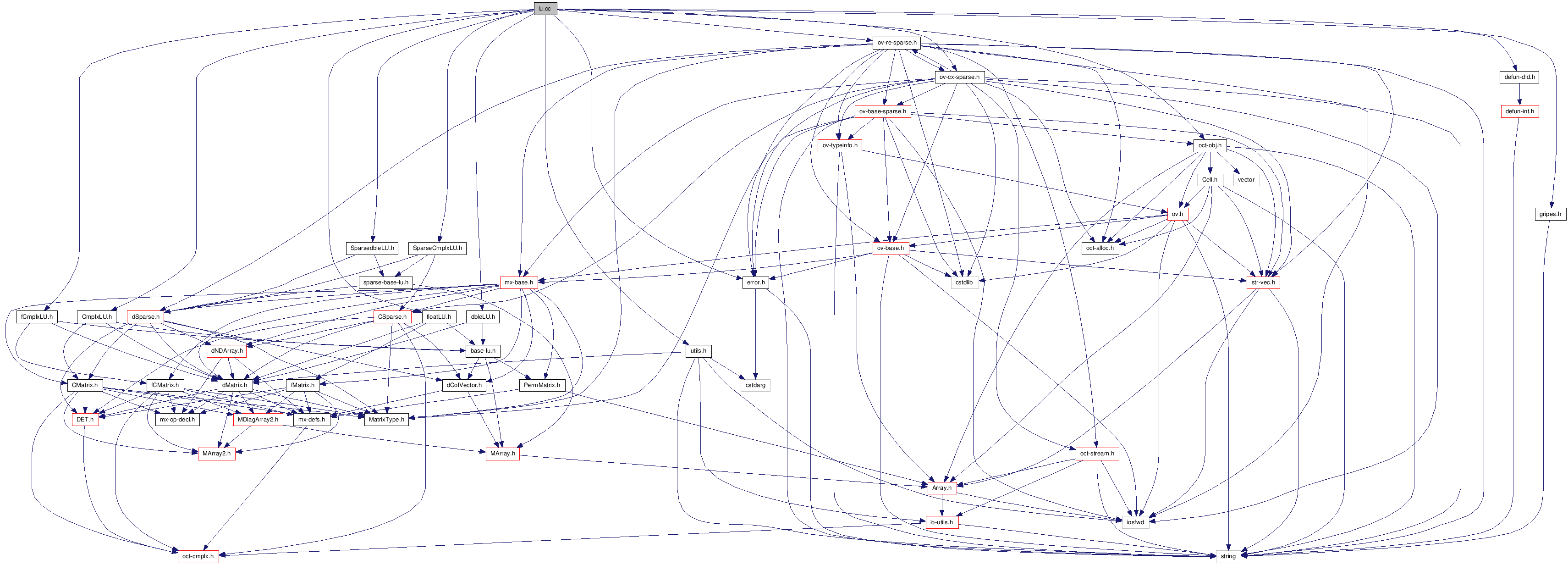| | DEFUN_DLD (lu, args, nargout,"-*- texinfo -*-\n\
@deftypefn {Loadable Function} {[@var{l}, @var{u}, @var{p}] =} lu (@var{a})\n\
@deftypefnx {Loadable Function} {[@var{l}, @var{u}, @var{p}, @var{q}] =} lu (@var{s})\n\
@deftypefnx {Loadable Function} {[@var{l}, @var{u}, @var{p}, @var{q}, @var{r}] =} lu (@var{s})\n\
@deftypefnx {Loadable Function} {[@dots{}] =} lu (@var{s}, @var{thres})\n\
@deftypefnx {Loadable Function} {@var{y} =} lu (@dots{})\n\
@deftypefnx {Loadable Function} {[@dots{}] =} lu (@dots{}, 'vector')\n\
@cindex LU decomposition\n\
Compute the LU decomposition of @var{a}. If @var{a} is full subroutines from\n\
@sc{lapack} are used and if @var{a} is sparse then UMFPACK is used. The\n\
result is returned in a permuted form, according to the optional return\n\
value @var{p}. For example, given the matrix @code{a = [1, 2; 3, 4]},\n\
\n\
@example\n\
[l, u, p] = lu (a)\n\
@end example\n\
\n\
@noindent\n\
returns\n\
\n\
@example\n\
@group\n\
l =\n\
\n\
1.00000 0.00000\n\
0.33333 1.00000\n\
\n\
u =\n\
\n\
3.00000 4.00000\n\
0.00000 0.66667\n\
\n\
p =\n\
\n\
0 1\n\
1 0\n\
@end group\n\
@end example\n\
\n\
The matrix is not required to be square.\n\
\n\
Called with two or three output arguments and a spare input matrix,\n\
then @dfn{lu} does not attempt to perform sparsity preserving column\n\
permutations. Called with a fourth output argument, the sparsity\n\
preserving column transformation @var{Q} is returned, such that\n\
@code{@var{p} * @var{a} * @var{q} = @var{l} * @var{u}}.\n\
\n\
Called with a fifth output argument and a sparse input matrix, then\n\
@dfn{lu} attempts to use a scaling factor @var{r} on the input matrix\n\
such that @code{@var{p} * (@var{r} \\ @var{a}) * @var{q} = @var{l} * @var{u}}.\n\
This typically leads to a sparser and more stable factorization.\n\
\n\
An additional input argument @var{thres}, that defines the pivoting\n\
threshold can be given. @var{thres} can be a scalar, in which case\n\
it defines UMFPACK pivoting tolerance for both symmetric and unsymmetric\n\
cases. If @var{thres} is a two element vector, then the first element\n\
defines the pivoting tolerance for the unsymmetric UMFPACK pivoting\n\
strategy and the second the symmetric strategy. By default, the values\n\
defined by @code{spparms} are used and are by default @code{[0.1, 0.001]}.\n\
\n\
Given the string argument 'vector', @dfn{lu} returns the values of @var{p}\n\
@var{q} as vector values, such that for full matrix, @code{@var{a}\n\
(@var{p},:) = @var{l} * @var{u}}, and @code{@var{r}(@var{p},:) * @var{a}\n\
(:, @var{q}) = @var{l} * @var{u}}.\n\
\n\
With two output arguments, returns the permuted forms of the upper and\n\
lower triangular matrices, such that @code{@var{a} = @var{l} * @var{u}}.\n\
With one output argument @var{y}, then the matrix returned by the @sc{lapack}\n\
routines is returned. If the input matrix is sparse then the matrix @var{l}\n\
is embedded into @var{u} to give a return value similar to the full case.\n\
For both full and sparse matrices, @dfn{lu} looses the permutation\n\
information.\n\
@end deftypefn") |
| | DEFUN_DLD (luupdate, args,,"-*- texinfo -*-\n\
@deftypefn {Loadable Function} {[@var{L}, @var{U}] =} luupdate (@var{l}, @var{u}, @var{x}, @var{y})\n\
@deftypefnx {Loadable Function} {[@var{L}, @var{U}, @var{P}] =} luupdate (@var{L}, @var{U}, @var{P}, @var{x}, @var{y})\n\
Given an LU@tie{}factorization of a real or complex matrix\n\
@w{@var{A} = @var{L}*@var{U}}, @var{L}@tie{}lower unit trapezoidal and\n\
@var{U}@tie{}upper trapezoidal, return the LU@tie{}factorization\n\
of @w{@var{A} + @var{x}*@var{y}.'}, where @var{x} and @var{y} are\n\
column vectors (rank-1 update) or matrices with equal number of columns\n\
(rank-k update).\n\
Optionally, row-pivoted updating can be used by supplying\n\
a row permutation (pivoting) matrix @var{P};\n\
in that case, an updated permutation matrix is returned.\n\
Note that if @var{L}, @var{U}, @var{P} is a pivoted LU@tie{}factorization\n\
as obtained by @code{lu}:\n\
\n\
@example\n\
[@var{L}, @var{U}, @var{P}] = lu (@var{A});\n\
@end example\n\
\n\
then a factorization of @code{@var{a}+@var{x}*@var{y}.'} can be obtained either as\n\
\n\
@example\n\
[@var{L1}, @var{U1}] = lu (@var{L}, @var{U}, @var{P}*@var{x}, @var{y})\n\
@end example\n\
\n\
or\n\
\n\
@example\n\
[@var{L1}, @var{U1}, @var{P1}] = lu (@var{L}, @var{U}, @var{P}, @var{x}, @var{y})\n\
@end example\n\
\n\
The first form uses the unpivoted algorithm, which is faster, but less stable.\n\
The second form uses a slower pivoted algorithm, which is more stable.\n\
\n\
Note that the matrix case is done as a sequence of rank-1 updates;\n\
thus, for k large enough, it will be both faster and more accurate to recompute\n\
the factorization from scratch.\n\
@seealso{lu,qrupdate,cholupdate}\n\
@end deftypefn") |

